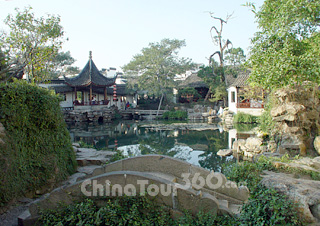 Garden of the Master of the Nets, Suzhou
Garden of the Master of the Nets, Suzhou
Located in No.11 Kuojiatou Lane, Daichengqiao Road, southeast of Suzhou City, the Garden of Master of Nets (Wangshiyuan) is a typical residential garden, similar to most small and medium-sized classical gardens in South China. It is one of the four famous city gardens to be rated a 4A-level national scenic area, listed in 'World Heritage Site'.
Built in 1174, the year of Chunxi in the Southern Song Dynasty (1127 - 1279), Garden of Master of Nets was privately owned. It was named '10,000 Books' Hall' on account of its library holdings. In the Qing Dynasty (1644 - 1911), it was renamed 'Wangshi', master of nets (fishermen), because the garden neighbored the Wangsi Lane which mimicked 'wangshi', indicating a fishing hermit.
Taking up an area of 1.3 acres, the garden is famous for its exquisite buildings and ingenious layout. The designer made full uses of the limited space to bring about elegance in a garden with a distinctive theme. The Chinese garden 'Mingxuan' in the Metropolitan Museum of Art in New York City was based on the Peony Study (Dianchunyi) in this garden.
Built in the prosperous Qing Dynasty style, Garden of Master of Nets comes in three major sections: the east section of house area, the central section of scenic area, and the west section of the inner garden. Entering the gate of the garden, you will see the east section first, where there is a Gate Hall, a Sedan Chair Hall, a Main Hall, the 10,000 Books' Hall, the First Gate Hall in South of Yangtze River, an inner hall, the Xiexiu Tower, and the Cloud Stairway Tower. The central section centers on a small pond with an ancient bridge above, around which there are several halls and small yards such as The Daohe House, the Five Peaks' Library and the Meditation Study. On the banks of the pond, small pavilions, trees and stones cover the larger houses behind them, dividing the section into different layers. The west section - the inner garden is made up of the Luhua House, Hanbi Spring, the Cold Spring Pavilion, and the Peony Study. All of the buildings are characterized by delicateness, low height and brightness.
Apart from the delicate buildings and ponds, various traditional performances are put on between 19:30 and 22:00 daily from middle March until middle November. There are traditional music, dance, instruments shows, as well as Kunqu Opera. Usually, there are 8 performances every night, each of which takes about 10 minutes. The performers always wear vivid historical costumes, and then move on to another hall, pavilion or tower for a repeat performance.
![]() Entrance Fee:
Entrance Fee:
CNY 30 (Apr. 16th to Oct. 30)
CNY 20 (Oct. 31st to Apr. 15th)
CNY 80 (during night)
![]() Opening Hours
Opening Hours
07:30 - 17:30 (Mar. 1st to Nov. 15th)
07:30 - 17:00 (Nov. 16th to Feb. 29th)
![]() Transportation: Bus No. 529 (29), 931 (31), 55, 202 (2), 47, 204 (4), 501 (401), 511 or Tourism Bus No. 2 and get off at Wangshiyuan stop.
Transportation: Bus No. 529 (29), 931 (31), 55, 202 (2), 47, 204 (4), 501 (401), 511 or Tourism Bus No. 2 and get off at Wangshiyuan stop.







